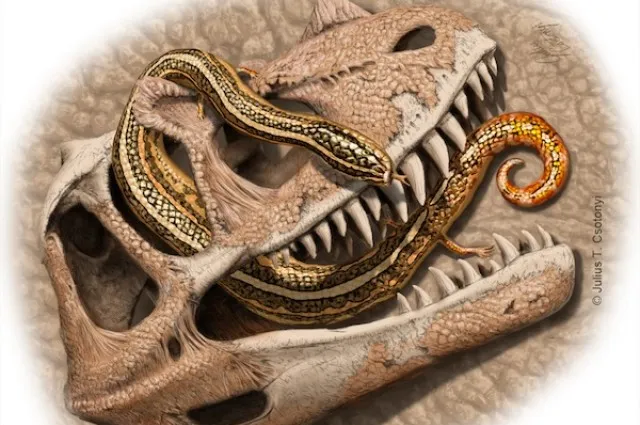In This Jurassic Boneyard, It’s Not Size That Counts
A rich cache of fossils in Colorado is valuable not for the big dino bones but the relatively tiny fossils that are still being dug up.
/https://tf-cmsv2-smithsonianmag-media.s3.amazonaws.com/filer/0e/34/0e346ecd-f94d-40b4-a9c6-6c5b167746c3/arizona_october_2011_291.jpg)
On the edge of Fruita, Colorado, scattered through a half square mile of red and gray rock, is one of the richest Jurassic boneyards anywhere. Over the years paleontologists have excavated the remains of a beautifully-preserved Ceratosaurus, the bones of at least six Allosaurus strewn together in death, and other Jurassic classics from this pocket of geological riches.
But the most magnificent fossils to come out of the Fruita Paleo Area aren’t giants like Apatosaurus and Stegosaurus. What makes this 150-million-year old spot so special is that it contains an exquisite record of Jurassic life at a much smaller scale.
Even though paleontologists and amateur naturalists knew about fossils in the hills around Fruita since the 1890s, it wasn’t until 1975 that the wonders of what would become the Fruita Paleo Area started to become known.
In that year, California State University paleontologist George Callison brought his students to exposures of the Morrison Formation, the rock layer where most Jurassic-era fossils in North America are found, in the deserts of western Colorado. Their mission: To look for the animals that scurried and slithered beneath the feet of Brachiosaurus and other Jurassic titans. While stopping to tie his boots, so the story goes, then-graduate student Jim Clark noticed black flecks in a piece of sandstone that turned out to be the bones of a three-foot-long crocodile that looks like a reptilian version of a small greyhound.
Clark’s crocodile was named Fruitachampsa in 2011. Exactly how this small saurian made its living is unclear, but its bones have turned up at another rarity in the Fruita Paleo Area – the nesting site of a small, herbivorous dinosaur called Dryosaurus, with preserved eggshell as well as the bones of young dinosaurs. The evidence is only circumstantial, simply placing Fruitachampsa at the scene, but the discovery of the odd croc’s bones among the hatchlings might hint that this blunt-snouted carnivore had a taste for eggs and unwary infants.
Fruitachampsa wasn’t the only small animal to turn up in Fruita. In 1987 Callison wrote that his team’s scratchings at the Fruita Paleo Area rock had yielded some vertebrae that looked very much like they belonged to a snake. Other experts thought a lizard identification fit better, but, just last year, Callison’s hunch turned out to be right – the tiny bones had once formed the spine of Diablophis, an early snake that would have still had limbs as it slithered through the forests and floodplains of the Jurassic world. Other discoveries in the area include Fruitadens – a dinosaur with tusk-like teeth and one of the smallest ever found – named in 2010, and the ant-eating mammal Fruitafossor announced by paleontologists in 2005.

Such fossils come from pockets of delicate preservation called microsites, and they’re quite rare in the Jurassic Morrison Formation, says Museums of Western Colorado paleontologist Julia McHugh. She and her crew continue to sift through the sites that Callison and his students identified back in the 70s, and this is because of the unprecedented view that small animals can provide of the habitat back when Allosaurus stalked this land. “Small animals give you a more detailed picture of an ecosystem,” McHugh says, particularly because they “tend to have larger populations and are more sensitive to environmental changes.” The small crocodiles, mammals, snakes, lizards, and other animals of the Fruita Paleo Area are more likely to provide insights about what the world was like at the time than the comparatively enormous dinosaurs that fill museum halls.
And it’s not just animals. Just last year, McHugh says, a Jurassic pine cone was found in the Fruita Paleo Area that may allow experts to identify at least one of the conifer species that grew there.
“After decades of excavation, the FPA is still generating new discoveries of evolution,” McHugh says.
There are likely still transformative tales to be drawn from the rocks on the outskirts of town. “Other Morrison microsites further north have produced amphibian fossils,” McHugh says, but these delicate ecological indicators have yet to be found in Fruita. With luck, they’ll soon peek out of this exceptional Jurassic graveyard.
/https://tf-cmsv2-smithsonianmag-media.s3.amazonaws.com/accounts/headshot/RileyBlack.png)
/https://tf-cmsv2-smithsonianmag-media.s3.amazonaws.com/accounts/headshot/RileyBlack.png)